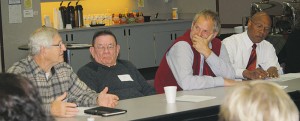
Former Marysville mayor Dennis Kendall (left) makes a point as state senator John McCoy, state representative Hans Dunshee and Snohomish County Executive John Lovick listen during the Marysville School District’s forum on Jan. 6.
By Christopher Andersson, North County Outlook
The education landscape in Washington, including increasing instructional hour requirements, more stringent accountability and additional initiatives, was discussed on Jan. 6 when Marysville School District leaders met with Washington state representatives.
Increasing Hours
The amount of instructional hours that school districts must provide to high school students may be increasing next fall.
The Washington state legislature increased the current 1000 instructional hour requirement to 1080, or the equivalent of 180 six-hour days.
The Quality Education Council’s survey of 128 Washington districts shows that less than half are currently meeting the requirement.
School districts around Washington have been looking at their options, mainly consisting of adding 10 to 15 minutes to the schedule or cutting out the majority of half-day and late-start days.
“It is not an easy implementation for many districts. It would require some pretty formidable collective bargaining, as they’re changing the conditions of work. The six-hour day takes away many of the options districts have for collaboration time,” said Jerry Jenkins, superintendent of Northwest 189 Educational Service District.
Marysville’s assistant superintendent Ray Houser said it will be a challenge for the district to reach 1080. They currently average close to 1000.
However, organizations like the National Center of Time and Learning support action that increases instructional hours like Washington state’s legislation.
Studies from the center show a positive correlation between expanding the school day or school year and increased student achievement.
The main concern from Marysville administrators and staff is that they will lose the half-days they use to collaborate and improve their teaching.
“To put an extra requirement of 1080 hours and not put in any additional funding for collaboration time or professional development puts districts in a difficult spot because that’s critical in order to have an effective program,” said Arden Watsen, president of the Marysville Education Association.
State Senator John McCoy said he is going to try to delay the 1080 instructional hour requirement and that the decision to pass it was based on incomplete data.
New Standards and Accountability
Washington state will fully adopt the Common Core State Standards next year and has also implemented the Teacher Principal Evaluation Project; however, the large number of new systems is creating ‘initiative fatigue,’ say Marysville education leaders.
The Common Core State Standards are a nationwide set of standards designed to replace statewide models.
“I’ve been an educator and I didn’t understand or underestimated the impact of them. I thought we were just setting the bar higher, but it’s not just that, we’re also changing the running path to get to the bar,” said Jenkins.
The Teacher Principal Evaluation Project provides a new system to evaluate teachers and principals.
While the Marysville leaders thought the two initiatives were good, they also emphasized the need for focus and stability.
“Continuous change and throwing ‘just one more thing’ in kills the momentum,” said Marysville school board president Tom Albright. “I see good things happening so I hope [state representatives] will find ways of fending off all these initiatives that try to throw one more thing on top.”
State representative Hans Dunshee said that all the laws do tend to take away time from teachers.
“All these legislators love to pass education bills and say they’re helping schools. They’re good intentioned but they really are sucking a lot of time. I think the best accountability was the school board member you could fire, but we are moving further and further away from that,” he said.
Students have faced some of the consequences of accountability as well. The amount of standardized testing is taking away from structured class time, said McCoy.
“I will continue my assault on standardized testing. I don’t think they’re productive and a lot of kids are absolutely afraid of them. There are some that are just poor test takers,” he said. “The teachers know where the students are at. They know what their students need. We legislators don’t need to be down in the nitty gritty.”
Tribal History
The need to include all aspects of local history in the curriculum, especially information about the local Native American tribes, is vital, according to Tulalip leaders.
“We are not just trying to get native students through school, but through school with some pride and balance,” said Tulalip Tribes vice-chair Deborah Parker. “We try and instill our cultural values and they go to school and it changes them, so how do we teach our students and feel like they’re still native?”
Curriculum that is inclusive to Native American history and culture will help to make Native American students feel included as well, and the current levels in most schools are not adequate, she said.
Senator McCoy spoke on HB 1495, a bill he introduced and passed in 2005 which mandated that Washington tribal history must be taught in public schools. Even though nine years have passed since that time “only 20 to 25 percent of schools have implemented it,” he said.
